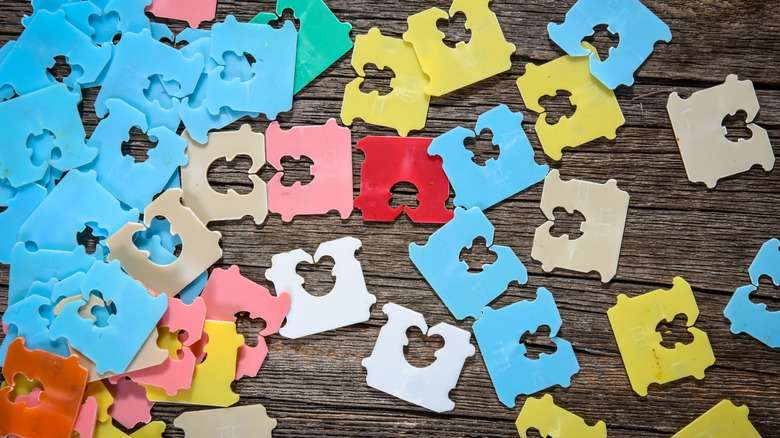The Unspoken Code Behind Colored Plastic Bread Tags
The journey of the food supply chain — from farm to factory, through packaging and transportation, and finally to supermarket shelves — can be quite extensive. It's no wonder that insider protocols exist on every level, even down to the twisty ties and plastic clip tags on bags of bread. If you thought they were colorfully cute for aesthetic reasons, it's time for a little tidbit of trivia — one that also happens to be useful in evaluating the freshness of that loaf of bread in your hand.
The colors of bread enclosures in the United States almost universally refer to the day of the week on which they left the oven. Since bread rarely stays on store shelves for more than a week, you'll be able to determine exactly which day within the previous seven days the bread was baked and packaged. It all comes down to five colors, corresponding to the five days in which bread bakers do their thing.
On Wednesdays and Sundays, most bakeries take a break from bread production, leaving the remaining five days designated for the color-coded enclosures. There's a system that's not exactly secret, just an insider practice that's understood within the industry. Fortunately, it's one that's easy to understand and memorize, potentially helping you walk proudly out the door with the freshest, fluffiest loaf of bread.
Colors, days, and alphabets indicate freshness of your bread
It's always wise to check the "best by" dates on any food product, but deciphering them is not always straightforward. After reaching for your glasses or flipping packaged foods over and around and upside down, you might find an obscure location with a faintly printed date, sometimes smeared or indecipherable. Well, here's the alternative, which only applies to bread products, and it's a good one. A quick glimpse at the highly visible bread clip reveals either blue, green, red, white, or yellow coloring, each indicating baking days. The colors that correspond to the days of the week are as follows: blue for Monday, green for Tuesday, red for Thursday, white for Friday, and yellow for Saturday.
Note that the colors are in alphabetical order, ascending as the day of the week progresses. The system is intended to keep grocery aisles stocked with the freshest bread, allowing stocking personnel to easily identify bread that needs to be rotated out of the store. So, it's not something that's crucial for you to remember, but rather just an extra tool in your culinary bag of tricks.
What's included and what's not in the color coded bread tags
While the word "bread" often brings to mind images of fluffy loaves — ranging from white and wheat to pumpernickel, oat, and raisin — these are not the only bread products that benefit from this simple, low-tech freshness identification method. Think English muffins, bagels, buns, naan, pita, crumpets, flatbreads, and just about any other type of bread you can imagine.
Keep in mind that some bakeries may have their own systems that differ from this universally color-coded one. This might be the case for certain artisan breads, products from small local bakeries, or those baked in-store with minimal labeling. In that case, the fresh-bread section of your supermarket may print out a computer label including the date. It's rare that fresh loaves of bread in onsite stores would linger for more than a day or two, and they often come open-bagged in paper or cellophane rather than plastic.



